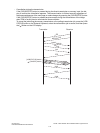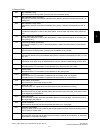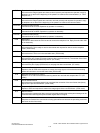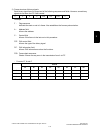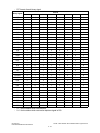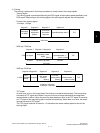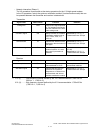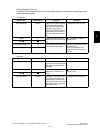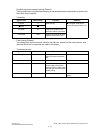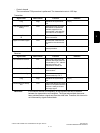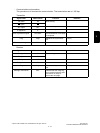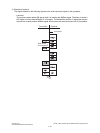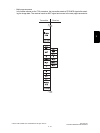
GD-1220/1221 © 2006 - 2008 TOSHIBA TEC CORPORATION All rights reserved
DIALING/COMMUNICATION CONTROL
3 - 14
- Network interaction (Phase 1)
The V.8 procedure is performed as the startup procedure for the V.34 high-speed modem.
In the V.8 procedure, mainly the optimum modulation method (V series modem mode) that can
be operated between the transmitter and receiver is determined.
Transmitter
Receiver
*1 V.21 (L) ..........Low frequency channel defined by the V.21 recommendation 1,080±100 Hz
(980 Hz: 1, 1,180 Hz: 0)
V.21 (H) ..........High frequency channel defined by the V.21 recommendation 1,750±100 Hz
(1,650 Hz: 1, 1,850 Hz: 0)
Signal name Abbreviation Function Remarks
Calling tone CNG 1100 Hz tone signal specified
by T.30 indicating the sender
is a FAX machine in the auto-
matic calling mode.
-
Call Menu signal CM Mainly indicates an available
modulation method such as
V.21, V.27ter, V.29, V.17,
V.34, etc.
Modulated by V.21 (L) *1.
Transmission rate: 300 bps
CM terminator CJ Indicates the detection of the
JM signal or the termination of
CM signal.
Modulated by V.21 (L) *1.
Transmission rate: 300 bps
Call Indicator signal CI Indicates the general commu-
nication functions. It is sent
when the V.8 procedure is
restarted.
For the late start only.
(P3-20)
Modulated by V.21 (L) *1.
Transmission rate: 300 bps
Signal name Abbreviation Function Remarks
Answer amplitude tone ANSam 2100 Hz tone signal ampli-
tude-modulated to 15 Hz.
Tone equivalent to CED of the
conventional machine.
Joint Menu signal JM Indicates the terminal type
such as a FAX machine.
Response to a CM sent from
the transmitter and informs
available modulation method.
Modulated by V.21 (H) *1.
Transmission rate: 300 bps



